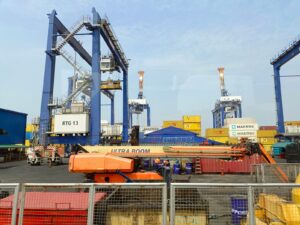IoT’s Transformative Impact on Logistics
Enhanced Visibility and Tracking
The adoption of IoT in logistics by companies like Amazon has revolutionized supply chain management by significantly enhancing visibility and tracking capabilities. With the integration of IoT devices, logistics operations now benefit from real-time monitoring of shipments, providing accurate location data and condition reports. This advancement ensures that businesses can maintain a higher level of oversight and control over their supply chains, which is crucial for maintaining efficiency and reducing delays. In bustling commercial centers like Riyadh and Dubai, where the speed and reliability of supply chains are paramount, the enhanced tracking provided by IoT is a game-changer.
Moreover, the use of IoT in logistics allows companies to anticipate and mitigate potential disruptions before they impact operations. For example, sensors can detect temperature fluctuations in perishable goods, enabling timely interventions to prevent spoilage. This capability is particularly valuable for businesses dealing with sensitive products, ensuring that quality is maintained from origin to destination. The visibility provided by IoT also facilitates more informed decision-making, as managers have access to comprehensive data that helps optimize routes, reduce fuel consumption, and enhance overall logistical efficiency.
Improved Inventory Management
Inventory management has also seen significant improvements with the advent of IoT technology in logistics. The ability to monitor inventory levels in real time allows companies to maintain optimal stock levels, reducing both excess inventory and stockouts. This balance is critical for businesses operating in fast-paced markets like Saudi Arabia and the UAE, where consumer demand can fluctuate rapidly. IoT-enabled inventory management systems can automatically reorder supplies when levels drop below a predetermined threshold, ensuring that businesses are always prepared to meet customer demand without overstocking.
Furthermore, IoT technology streamlines warehouse operations by enabling automated systems to manage inventory placement and retrieval. This automation reduces human error, increases efficiency, and allows for more accurate forecasting and planning. For instance, in Amazon’s warehouses, IoT devices track the movement of goods and manage the placement of items for faster and more efficient order fulfillment. This level of precision and automation in inventory management not only enhances operational efficiency but also contributes to significant cost savings.
Future Prospects and Innovations in IoT Logistics
Integration with Artificial Intelligence and Blockchain
The future of IoT in logistics is set to be even more transformative with the integration of artificial intelligence (AI) and blockchain technology. AI can analyze the vast amounts of data generated by IoT devices to provide actionable insights and predictive analytics. This capability enables logistics companies to optimize their operations further, from route planning to demand forecasting. In regions like Riyadh and Dubai, where logistical efficiency is critical for maintaining competitive advantage, the combination of IoT and AI can lead to unprecedented levels of operational excellence.
Blockchain technology adds another layer of security and transparency to the supply chain. By recording every transaction and movement of goods on an immutable ledger, blockchain ensures that data is tamper-proof and can be verified by all parties involved. This transparency is especially valuable in high-stakes environments, such as the pharmaceutical industry, where traceability and authenticity of products are paramount. The integration of blockchain with IoT in logistics not only enhances trust and accountability but also streamlines processes by reducing the need for intermediaries.
Adapting to Emerging Technologies and Market Demands
As IoT technology continues to evolve, logistics companies must adapt to emerging technologies and shifting market demands. The integration of IoT with the metaverse, for instance, presents new opportunities for immersive and interactive logistics management. Virtual reality (VR) and augmented reality (AR) technologies can be used to simulate warehouse environments, train employees, and optimize logistical processes in a virtual setting before implementing them in the real world. This innovative approach allows for more effective planning and execution, reducing the risk of errors and improving overall efficiency.
Additionally, the adoption of IoT in logistics aligns with the broader trend of generative AI, where AI algorithms can generate new solutions and strategies based on existing data. This capability is particularly relevant in dynamic markets like those in Saudi Arabia and the UAE, where businesses must continuously innovate to stay ahead. By leveraging generative AI, logistics companies can develop more effective and adaptive strategies, ensuring that they remain responsive to changing market conditions and customer expectations.
Conclusion
The adoption of IoT in logistics has revolutionized supply chain management, bringing enhanced visibility, improved inventory management, and significant cost savings. As companies in Saudi Arabia, UAE, Riyadh, and Dubai embrace these advancements, the integration of emerging technologies like AI, blockchain, and the metaverse will further drive innovation and efficiency in logistics. By staying at the forefront of these developments, businesses can ensure sustained success and leadership in the ever-evolving global market.
—
#IoTAdoption #LogisticsInnovation #SupplyChainManagement #ArtificialIntelligence #Blockchain #TheMetaverse #GenerativeAI #ModernTechnology #BusinessSuccess #LeadershipSkills #ProjectManagement













